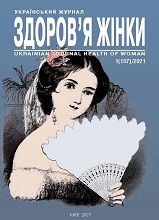The influence of anthropometric factors, obstetrical and gynaecological history on the risk of implantation failure after in vitro fertilization
DOI:
https://doi.org/10.15574/HW.2021.157.12Keywords:
implantation failure, infertility, assisted reproductive technologies, in vitro fertilization (IVF)Abstract
Infertility is a significant demographic and socio-economic problem, which is solved with assisted reproductive technologies. Relevance of the infertility problem continues to grow, which leads to the search for new methods to improve the success of assisted reproductive technologies.
Purpose — to analyze the effect of anthropometric factors, obstetrical and gynaecological history on the risk of implantation failure in women with infertility who have fertilization in vitro.
Materials and methods. An analysis of 106 infertile women who were treated with assisted reproductive technologies in September 2019 — February 2021. The control group consisted of women who received infertility treatment according to the standard treatment regimens: controlled ovarian stimulation, gamete sampling, intracytoplasmic sperm injection and embryo transfer. The study group included patients who received antiplatelet agents, anticoagulants and intravenous immunoglobulins G in addition to the standard therapy.
Results. In this study, no differences were found in the two study groups regarding age, height, weight, body mass index, menarche, menstrual duration, coitus (p>0.05). During the analysis, it was found that with increasing age of a woman, the risk of unsuccessful implantation increases, OR=1.11 (95% CI 1.01–1.21) for each year, with increasing patient height, the risk decreases (p=0.006), OR=0.85 (95% CI 0.76–0.96) for each centimetre, with an increase in the number of sexual intercourses per week (p=0.012), OR=1.71 (95% CI 1.12–2.60) the risk increases by each unit. Implantation success with using modified treatment regimens with additional aspirin, low molecular weight heparins, intravenous immunoglobulins G, was higher (p=0.049), OR=0.37 (95% CI 0.14–0.99) compared to the standard infertility treatment scheme.
Conclusions. This study found unfavourable effects of age, woman's height, and sexual intercourses on embryo implantation. Additional use of aspirin, low molecular weight heparin, intravenous immunoglobulin G as a supplemental therapy to standard treatment regimens of infertility with IVF had a successful impact on the effectiveness of embryo implantation.
The research was carried out in accordance with the principles of the Helsinki declaration. The study protocol was approved by the Local Ethics Committee of the participating institution. The informed consent of the patient was obtained for conducting the studies.
No conflict of interest was declared by the authors.
References
Bashiri A, Halper KI, Orvieto R. (2018). Recurrent Implantation Failure-update overview on etiology, diagnosis, treatment and future directions. Reproductive Biology and Endocrinology. 16 (1): 1-18. https://doi.org/10.1186/s12958-018-0414-2; PMid:30518389 PMCid:PMC6282265
Berestoviy VO, Mahmood AA, Berestoviy OO et al. (2021). An overview of autoimmunity in implantation failure: a literature review. Wiadomosci Lekarskie (Warsaw, Poland: 1960). 74 (3; 2): 777-783. https://doi.org/10.36740/WLek202103240; PMid:33843653
Berker B, Taskin S, Kahraman K et al. (2011). The role of low-molecular-weight heparin in recurrent implantation failure: a prospective, quasi-randomized, controlled study. Fertility and sterility. 95 (8): 2499-2502. https://doi.org/10.1016/j.fertnstert.2010.12.033; PMid:21244861
Hernandez-Vargas P, Munoz M, Dominguez F. (2020). Identifying biomarkers for predicting successful embryo implantation: applying single to multi-OMICs to improve reproductive outcomes. Human reproduction update. 26 (2): 264-301. https://doi.org/10.1093/humupd/dmz042; PMid:32096829
Li J, Chen Y, Liu C et al. (2013). Intravenous immunoglobulin treatment for repeated IVF/ICSI failure and unexplained infertility: a systematic review and a meta-analysis. American Journal of Reproductive Immunology. 70 (6): 434-447. https://doi.org/10.1111/aji.12170; PMid:24238107
Orvieto R, Meltcer S, Nahum R et al. (2009). The influence of body mass index on in vitro fertilization outcome. International Journal of Gynecology & Obstetrics. 104 (1): 53-55. https://doi.org/10.1016/j.ijgo.2008.08.012; PMid:18957271
Rienzi L, Cimadomo D, Vaiarelli A et al. (2021). Measuring success in IVF is a complex multidisciplinary task: time for a consensus? Reproductive BioMedicine Online. https://doi.org/10.1016/j.rbmo.2021.08.012; PMid:34493463
Shapiro BS, Daneshmand ST, Desai J et al. (2016). The risk of embryo-endometrium asynchrony increases with maternal age after ovarian stimulation and IVF. Reproductive biomedicine online. 33 (1): 50-55. https://doi.org/10.1016/j.rbmo.2016.04.008; PMid:27178763
Stern C, Chamley L, Norris H et al. (2003). A randomized, double-blind, placebo-controlled trial of heparin and aspirin for women with in vitro fertilization implantation failure and antiphospholipid or antinuclear antibodies. Fertility and sterility. 80 (2): 376-383. https://doi.org/10.1016/S0015-0282(03)00610-1
Szamatowicz M, Szamatowicz J. (2020). Proven and unproven methods for diagnosis and treatment of infertility. Advances in medical sciences. 65 (1): 93-96. https://doi.org/10.1016/j.advms.2019.12.008; PMid:31923772
Zabolotko V. (2017). Informatsiino-statystychnyi dovidnyk pro dopomizhni reproduktyvni tekhnolohii v Ukraini. Kyiv: DZ «Tsentr medychnoi statystyky MOZ Ukrainy»: 12.
Downloads
Published
Issue
Section
License
Copyright (c) 2021 Ukrainian Journal Health of Woman

This work is licensed under a Creative Commons Attribution-NonCommercial 4.0 International License.
The policy of the Journal UKRAINIAN JOURNAL «HEALTH OF WOMAN» is compatible with the vast majority of funders' of open access and self-archiving policies. The journal provides immediate open access route being convinced that everyone – not only scientists - can benefit from research results, and publishes articles exclusively under open access distribution, with a Creative Commons Attribution-Noncommercial 4.0 international license (СС BY-NC).
Authors transfer the copyright to the Journal UKRAINIAN JOURNAL «HEALTH OF WOMAN» when the manuscript is accepted for publication. Authors declare that this manuscript has not been published nor is under simultaneous consideration for publication elsewhere. After publication, the articles become freely available on-line to the public.
Readers have the right to use, distribute, and reproduce articles in any medium, provided the articles and the journal are properly cited.
The use of published materials for commercial purposes is strongly prohibited.

